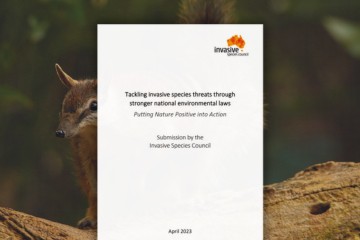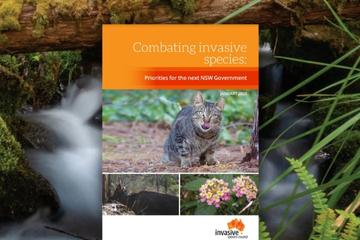It may be a poisoned chalice, but the new Threatened Species Commissioner Gregory Andrews is not daunted by the size of his challenge.
When I met with the commissioner last week he was full of confidence and enthusiasm, asked lots of questions and was interested in our focus on prevention.
The commissioner’s terms of reference include some ambitious outcomes:
- Priority threatened species are secured in the wild for at least the next 100 years.
- Targeted, practical and cost effective investment in threatened species conservation actions.
- A more strategic approach to threatened species conservation to better inform government policy, planning and investment.
Turning around the sorry state of Australia’s threatened species is an enormous and very important job. While there is some good work being done by governments and the community on particular species the overall trend is of abject failure. The number of Australian native species in trouble is growing rapidly, in many cases because of invasive species.
The 2011 Australian state of the environment report highlights the enormous threats invasive species pose to our native plants and wildlife: 60% of nationally endangered species are affected by invasive species and 15% by disease (mostly due to introduced pathogens).
It also notes that our natural heritage is under pressure from a ‘fast-growing number of invasive species’. Invasive species impacts on biodiversity were bleak: ‘very high’ impacts with ‘deteriorating’ trends, and management outputs and outcomes that are ‘ineffective’.
Feral cats
The new commissioner made it clear to us that tackling the problem of feral cats, the biggest killer of mammals in Australia, will be a high priority under his watch.
The development of a new toxic bait by Invasive Animals CRC is one promising advance. Actions that have broader ecological benefits should be given high priority. Conserving dingoes, for example, has merit as a method of cat and fox suppression and eradicating invasive species from islands creates sanctuaries for threatened species.
Focusing recovery efforts on keystone species such as predators, pollinators and diggers will lead to improved landscape health.
Key threatening processes
One of the most strategic approaches we can take to tackling invasive species is to reduce the threats facing a large number of threatened plants and animals.
The Environment Protection and Conservation Act provides for this through the listing of key threatening processes and the development of threat abatement plans. There are already 21 of these processes listed and, not surprisingly, two-thirds involve invasive species.
However, several of the listed invasive species threats do not have matching threat abatement plans and others have failed to deliver effective threat abatement, particularly those requiring agreement by many parties or challenge financial interests, even minor ones. More recently the Federal Government refused to list further invasive species threats.
Escaped garden and aquatic plants were listed in 2010 as a key threat, but no abatement plan was prepared and there has been little action to stop new weeds escaping from gardens. Nurseries are still selling many weedy plants, as they are permitted to do under inadequate and inconsistent state laws.
Five pastoral grasses in northern Australia were listed as a threat in 2009 and an abatement plan adopted. But little has been done to combat the problem – some are not even declared weed species in some states – and other similarly invasive grasses are still being planted.
The tramp ant threat abatement plan was useful in that it took a broad approach to the listing of two tramp ant species as a threatening process – red imported fire ants in 2003 and yellow crazy ants on Christmas Island (2005).
Four other serious tramp ant species not listed – electric ants, tropical fire ants, Argentine ants, African big headed ants – were included in the plan, which is administered by the federal agriculture department. But there has been little progress on most of the eight ‘very high priority’ actions, with the main focus being on emergency responses to red imported fire ant and yellow crazy ant infestations in Queensland.
What’s the strategy?
Australia’s biodiversity conservation strategy 2010-2030, agreed to by all Australian governments, has a target to reduce the impacts of invasive species by 10% by 2015[1]. This target has been ignored, with no development of plans to achieve it or even a baseline against which to measure progress.
As well as reducing the impacts of existing invasive threats, Australian governments should adopt a target to lower the rate of new invasive species establishing in the wild in Australia.
The other important strategic approach is prevention. Although it is highly cost-effective to eradicate an invasive species when numbers are low, it is far more cost-effective to prevent the invasive species from arriving in the first place.
State governments roughly indicate a 100:1 return on investment for prevention and 25:1 for eradication.
Institutional arrangements are critical. This affects how priorities are set, what resources are allocated and how laws are followed. To address the lack of focus on prevention, we have proposed the establishment of a new collaborative institution, Environment Health Australia.
We wish the commissioner well in his new role and hope he can make real progress. Success will not be his to achieve alone. Without a serious commitment by all levels of government we will have more reports of missed targets and further declines in the status of invasive species.
References:
1. By 2015, reduce by at least 10% the impacts of invasive species on threatened species and ecological communities in terrestrial, aquatic and marine environments.




